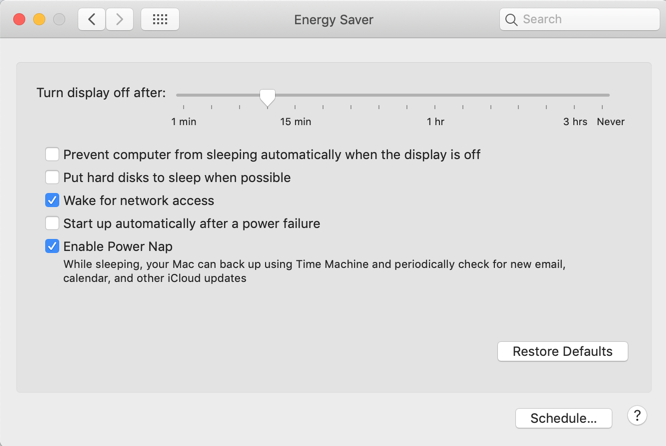Hello, this is just an example. I do not want to write a macro for this specific task.
I want to better understand the capabilities of KBM.
Is there a simple way to have a macro read whether Wake for Network Access is checked or not ?
thank you

Hello, this is just an example. I do not want to write a macro for this specific task.
I want to better understand the capabilities of KBM.
Is there a simple way to have a macro read whether Wake for Network Access is checked or not ?
thank you

thank you for your reply.
sorry, I don't understand.
I often use click at found image, but 'read' at found image, and generate a notification 'Wake for Network access is checked' ?
As they say, there's more than one way to s̶k̶i̶n̶ ̶a̶ ̶c̶a̶t̶ find an image:
[ "$( pmset -g | awk '/womp/ {print $2;}' )" = "1" ] && printf "true" || printf "false"
If you're goal is not so much to detect the status of the checkbox, but rather the setting that the checkbox represents, then this retrieves that setting. true equates to the checkbox being checked (i.e. Wake For Network Access is active); false otherwise. If you're happy with simply 1 and 0 instead of true and false, the shell code can be simplified to:
pmset -g | awk '/womp/ {print $2;}'
I appreciate this might not be what you had in mind if all you wish to observe is KM's capabilities rather than a solution to a problem.
it works very nicely. thanks.
If I understand correctly, the script is totally dependant on my understanding shell scripting. There is nothing obvious / recognizable to edit, unless you have a suggestion on how I could acquire a very narrow understanding of shell scripting applicable to mac system preferences windows which would allow me to edit the script and adapt to other windows. I have too much on my plate and am not going to embark on learning the ins and outs of shell scripting.
If I may trouble you with another script question.
I have this script which displays free space on my hard drive which I currently need because I am running out of space and have to check regularly.
df / | awk '{ print $5 }' | tail -n 1
It works well within a KBM macro but the result is displayed as a % which is not great.
Thanks very much for your help

thank you. Now I understand the logic. You told me about if then else in the past, and I forgot about it.
I will flagellate myself today to insure I remember next time.
thanks a lot.
@gglick
now I'm confused. I thought by reading the actions that the macro would only work if the window in question was open which it is not (I closed sys pref), and if it was open, I could see the setting and would not need a macro.
Here's what each part of the command does:
[ df / ] Displays information about the free space for the disk mounted at /, i.e. your main startup disk. The information is tabulated and will look something like this:
Filesystem 512-blocks Used Available Capacity iused ifree %iused Mounted on
/dev/disk1s1 975221040 865578296 99873792 90% 1419161 9223372036853356646 0% /
[ awk '{ print $5 }' ] This takes the output above and processes each line, printing only the text contained within the fifth field (column). The fifth field in the header line is "Capacity", and in the line below is "90%".
[ tail -n 1 ] This takes the output from the awk command, which would have been this:
Capacity 90%
and prints only the final line, which is what gives you your overall output.
If run the df command using the -H option, this returns the information as so-called Human Readable output, and looks like this:
Filesystem Size Used Avail Capacity iused ifree %iused Mounted on
/dev/disk1s1 499G 443G 51G 90% 1419160 9223372036853356647 0% /
I've bolded the information that will be of most interest to you, namely the total size of your hard disk; the amount of space used; and the amount of space available; each of which are evaluated in gigabytes, denoted by the suffix "G".
Specifically, the fourth column is the one containing the amount of free space remaining. Thus, with two small edits to the original command, you'll get the output returned as "51G" (or whatever remains on your hard drive):
df -H / | awk '{ print $4 }' | tail -1
You can also retrieve the information with AppleScript (I'm not suggesting this is better, but it's useful to have more than one option at your disposal):
tell application id "com.apple.systemevents" to return ¬
(startup disk's free space) * 100 div (2 ^ 30) / 100
startup disk's free space returns the information in bytes. The numerical manipulation yields the equivalent gigabyte value, to 2 decimal places, e.g. 52.24. There's a slight discrepancy between this result and the one given by df, which I'm not able to account for.
No, sorry.
extremely interesting and informative. thank you very much
just a thought about the discrepancy which is not am important issue
1- perhaps Gi vs GB ?
2- APFS time machine snapshots are for example counted if the calculation of Pathfinder disk size, but not with Finder
thanks again very much